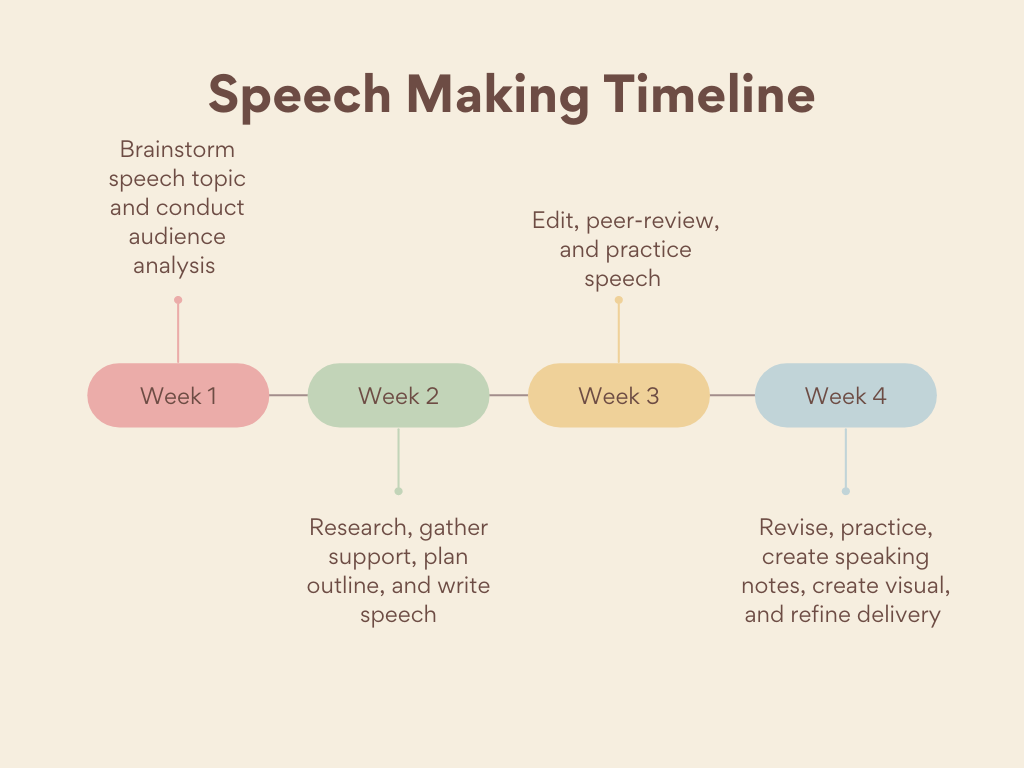7
Learning Objectives
- Demonstrate an understanding of proper speech delivery by learning the key elements of extemporaneous speaking and the time it will take to deliver the well-developed speech.
Extemporaneous Speaking
Extemporaneous speaking is a fancy way of saying: delivering a well-prepared speech. Extemporaneous speaking is not delivering a monologue or a memorized speech. Public speaking students often fall into the trap of under-preparing and under-practicing their speeches. This results in an, “Oh! no! I am not prepared and now I must read this outline word-for-word and hope for the best.” However, the best does not come to fruition and students that engage in this practice are disappointed when they lose substantial points from their speech grade due to lack of preparation, practice, and reading word-for-word from an outline. Just – don’t – do -it.
Here are a few ways you can engage in extemporaneous speaking:
- Know your speech topic
- Research your topic
- Create a timeline – research, writing, peer-review, practicing, editing, practicing again
- Create note cards to guide your speech
- Practice, practice, practice
- Know the difference between a memorized speech/monologue and dialogue
- connecting with your audience is key in extemporaneous speaking
Dialogue vs. Monologue
The first tenet of the dialogic perspective is that communication should be a dialogue and not a monologue. Lev Yakubinsky argued that even public speaking situations often turn into dialogues when audience members actively engage speakers by asking questions. He even claimed that nonverbal behavior (e.g., nodding one’s head in agreement or scowling) functions as feedback for speakers and contributes to a dialogue (Yakubinsky, 1997). Overall, if you approach your public speaking experience as a dialogue, you’ll be more actively engaged as a speaker and more attentive to how your audience is responding, which will, in turn, lead to more actively engaged audience members.
Build a Proper Timeline
- To ensure you have enough time for the assignment, create a timeline that works for your schedule
- It will take approximately four weeks to deliver an extemporaneous speech:
- Week 1 – Brainstorm your speech topic and conduct an audience analysis
- Week 2 – Research, gather support, plan outline, and write a speech
- Week 3 – Edit, peer-review, begin practicing your speech
- Week 4 – Revise, practice, create note cards, create a visual aid, and refine your delivery

Building on This Information
As you progress through this course, you will revisit proper extemporaneous speaking, the use of outlining, proper use of notecards, and delivering a strong speech. It is important to note that your audience deserves a speech that is interesting, thoughtful, and well-rehearsed. The audience is listening to you as the credible speaker in the room; in order to remain credible and professional, you will want to deliver an extemporaneous speech.
Key Takeaways
Students will want to become familiar with extemporaneous speaking in order to work towards a speech delivery that relies on effective speech strategies and not reading word-for-word from an outline.
- Extemporaneous speaking is a skill that public speaking students must hone in on before delivering their speech to an audience.
- Students will want to plan ahead to deliver a strong speech in the informative and persuasive speech weeks of this course.
- Creating a proper timeline will assist in delivering a well-developed extemporaneous speech.

